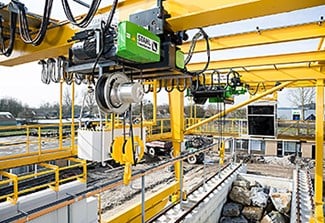Natural disasters and flooding are things that coastal cities all over the world want to protect themselves from. A Dutch research institute, Deltares, is committed to doing that, measuring, analyzing and reporting its findings on this to help cities do just that.
To do this, Deltares wanted to construct a new wave flume in Delft to enable dykes and breakwaters to be tested in realistic conditions with the aid of artificial waves. Both the flume itself and the gantry crane needed for the facility had to be built to an exacting design.
Deltares uses a specially designed gantry crane, travelling over the whole length of the basin, to construct the test dykes. One of its functions is to position sand and stones accurately in the flume using a grab. The crane operator then has a continuous clear view of everything from his mobile cabin, including the load area of the lorry next to the basin as well as the bed of the flume approximately 20 meters below.
Constructing test dykes demands fast, accurate work. STAHL CraneSystems designed an off-standard grab wire rope hoist as SH 6 twin drive concept to meet their needs. This wire rope hoist provides the required hoisting speed of up to 25 m/min with two rope drums and two hoist motors. A reeving system newly developed by STAHL CraneSystems, in which the compensating sheave is situated not between, but in a horizontal position alongside the wire rope hoists, enabled the headroom to be reduced by 30 % compared with a standard wire rope hoist. With dual-hoist operation, the grab shovel can operate with more controlled, steady movements.
A second wire rope hoist, also on the inside of the portal crane, is used to lift smaller construction vehicles onto the bed of the flume. Both wire rope hoists can be coupled for tandem operation and operated in synch by means of remote control. This is necessary for positioning the 20 ton steel partition wall when the basin needs to be shortened for certain trials.
Unusual design
For this project, both hoists needed a high classification (FEM 3m), although “only” safe working loads of 12.5 tons were required. This specification for the auxiliary hoist combined with a monorail trolley and the lifting height needed could not be met with a standard hoist. For this reason, CraneBuilders chose an AS 7 wire rope hoist and had STAHL CraneSystems design a customized monorail trolley so the wire rope hoist had both compact dimensions and a high classification.
Custom-built gantry crane
CraneBuilders’ skills were demonstrated in the dimensional calculations. The gantry had to pass through the maintenance shop doors, but also had to be high enough for the laboratory container to move beneath it, traveling along two internal rails independent of the crane during tests.
Well-designed
The crane had jibs more than 5 meters long for hoists and a crane cab on one side of the gantry to take up bulk material and loads parallel to the flume. A heavy counterweight on the opposite side of the gantry crane prevents it tipping when heavy loads are lifted on the jib.
Safe passenger transportation
Deltares’ scientists position sensors in the dyke to measure the effect of the waves. They can travel down into the flume in a power climber lifting platform mounted on the crane and easily reach the various position heights required. Sensors on the bottom of the cage automatically halt the lowering procedure if it touches the water. A safety circuit avoids collisions with the laboratory container travelling beneath the crane and prevents the hoists and lifting platform being operated simultaneously. The power supply to the crane gantry and the laboratory container was designed as a festoon cable system at a height of 4 meters to prevent measurement errors by the sensitive sensors.
Frugal giant
All of the gantry crane’s travel and hoist motors are frequency-controlled and can be operated with precision. The crane control, designed by CraneBuilders, feeds the energy generated by frequency inverters and brakes back into the grid, helping minimize the crane system’s total energy consumption.
At the service of science
Building dykes is a challenge. The gradient, material composition and distance from the sea must be precisely calculated, simulated and tested. As a nation with 26% of its surface area below sea level, the Dutch are experts in the field of dyke construction.
Threatened by global climate warming and rising sea levels, the country invests great sums in coastal and dyke research, CraneBuildersand STAHL CraneSystems are proud of the fact that their gantry crane will assist Deltares in its important research work.
North America - EN



